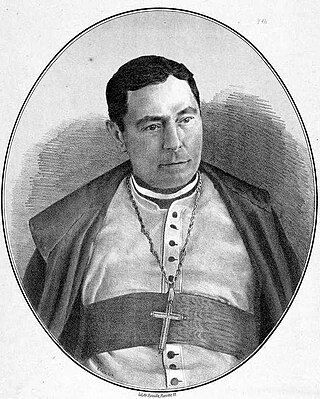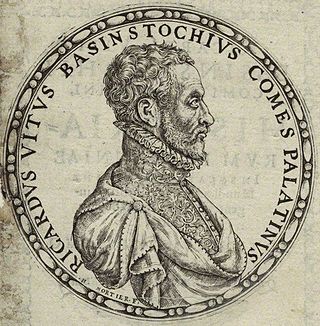Life
Born in County Galway, he was son of Peter Lynch of Shruell, by his wife, Mary Skerret. He joined the Order of St. Dominic, and made his profession in the Dominican convent of San Pablo, Seville, where he lived for many years. [1]
Lynch became lecturer in arts and philosophy in the convent, and then master of the students. In 1674 he was appointed to the chair of theology in the Colegio de Santo Tomás, Seville in 1674; the post followed a report on Lynch's pedigree from Ireland (later printed with annotations by James Hardiman). [1] [2] [3]
Lynch was elected by his brethren of the province of Andalucia to attend the congregation of the order held at Rome in 1686, over which he presided as moderator. He died in the Colegio de Santo Tomás at the end of 1697 or the beginning of the following year. [1]

The Order of Preachers, commonly known as the Dominican Order, is a Catholic mendicant order of pontifical right that was founded in France by a Castilian priest named Dominic de Guzmán. It was approved by Pope Honorius III via the papal bull Religiosam vitam on 22 December 1216. Members of the order, who are referred to as Dominicans, generally display the letters OP after their names, standing for Ordinis Praedicatorum, meaning 'of the Order of Preachers'. Membership in the order includes friars, nuns, active sisters, and lay or secular Dominicans. More recently, there have been a growing number of associates of the religious sisters who are unrelated to the tertiaries.

Luis de Molina was a Spanish Jesuit priest, theologian and jurist follower of Second scholasticism of the School of Salamanca. A staunch defender of free will in the controversy over human liberty and God's grace, his theology is known as Molinism.

Irish Colleges is the collective name used for approximately 34 centres of education for Irish Catholic clergy and lay people opened on continental Europe in the 16th, 17th and 18th centuries.

Jordan of Saxony, OP, was a German Catholic priest and one of the first leaders of the Dominican Order. His feast day is February 13.

The Dominican Order has been present in Ireland since 1224 when the first foundation was established in Dublin, a monastic settlement north of the River Liffey, where the Four Courts is located today. This was quickly followed by Drogheda, Kilkenny (1225), Waterford (1226), Limerick (1227) and Cork (city) (1229). The order was reestablished in the 19th century after having been driven out in the 17th century by laws against Catholic religious orders. During the Penal Laws, as other Irish Colleges were established on the continent, in 1633 the Irish Dominicans established, the College of Corpo Santo, Lisbon and College of the Holy Cross, Louvain (1624-1797) to train clergy for ministering in Ireland. San Clemente al Laterano in Rome, was entrusted to the Irish Dominicans in 1677. In 1855, St. Mary's Priory, Tallaght, was established to train members of the order, who would complete their clerical studies in Rome and be ordained in the Basilica San Clemente.
Daniel O'Daly, also known as Dominic Ó Dálaigh and Dominic de Rosario, was an Irish Dominican priest, diplomat and historian. He established the College of Corpo Santo in Lisbon, Portugal for Irish students wishing to study for the priesthood.
Domingo Ibáñez de Erquicia, OP was a Spanish Dominican priest and missionary. After teaching at the Colegio de Santo Tomas in Manila, he went to Japan in 1623, where he ministered incognito to the Catholic community for about ten years. Betrayed by an apostate, he was captured and executed. His feast day is 28 September.

The 17 Thomasian Martyrs were the 12 Dominican priests, 1 Franciscan priest and 3 Dominican bishops who became administrators, professors, or students in the University of Santo Tomas in Manila, they are venerated in the Catholic Church regarded them as a martyrs and declared as a saints and blesseds by several popes throughout the 20th and 21st century, All of them gave up their lives for their Christian faith, some in Japan, others in Vietnam, and in the 20th century, in Spain during the Spanish Civil War. Lorenzo Ruiz de Manila was among the lay companions of the Thomasian Martyrs of Japan, their feast day is celebrated every year on November 6.

Zeferino González y Díaz Tuñón was a Spanish Dominican theologian, and philosopher, Archbishop of Seville and cardinal.

The University of Santo Tomas is one of the oldest existing universities and holds the oldest extant university charter in the Philippines and in Asia. It was founded on April 28, 1611, by the third Archbishop of Manila, Miguel de Benavides, together with Domingo de Nieva and Bernardo de Santa Catalina. It was originally conceived as a school to prepare young men for the priesthood. Located Intramuros, it was first called Colegio de Nuestra Señora del Santísimo Rosario and later renamed Colegio de Santo Tomás in memory of Dominican theologian Saint Thomas Aquinas. In 1624, the colegio was authorized to confer academic degrees in theology, philosophy, and arts. On November 20, 1645, after representations by Vittorio Riccio, Pope Innocent X elevated the college to the rank of a university and in 1680 it was placed under royal patronage.
Richard Lynch was an Irish theologian and Jesuit.
John-Baptist Hackett was an Irish Catholic theologian.
Dominic Maguire O.P. was an Irish prelate of the Roman Catholic Church. A leading Jacobite in Ireland, he served as the Archbishop of Armagh and Primate of All Ireland from 1683 to 1707.

Antonin Cloche (1628–1720) was the Master of the Order of Preachers from 1686 to 1720.
Nicholas Lynch, Dominican priest and prior of Galway.

Richard White (1539–1611) was an English jurist and historian, in later life an expatriate scholar who became a Catholic priest.
Thomas Gore (1632–1684) was an English gentleman, known as a writer on heraldry.
Diego Álvarez was a Spanish theologian who opposed Molinism. He was archbishop of Trani from 1607 to his death.

The Basilica and Maximus Convent of Nuestra Señora del Rosario, popularly known as the Convent of Santo Domingo, is a Catholic religious complex located in the city of Lima, Peru.
![]() This article incorporates text from a publication now in the public domain : Lee, Sidney, ed. (1893). "Lynch, Dominic". Dictionary of National Biography . Vol. 34. London: Smith, Elder & Co.
This article incorporates text from a publication now in the public domain : Lee, Sidney, ed. (1893). "Lynch, Dominic". Dictionary of National Biography . Vol. 34. London: Smith, Elder & Co.









